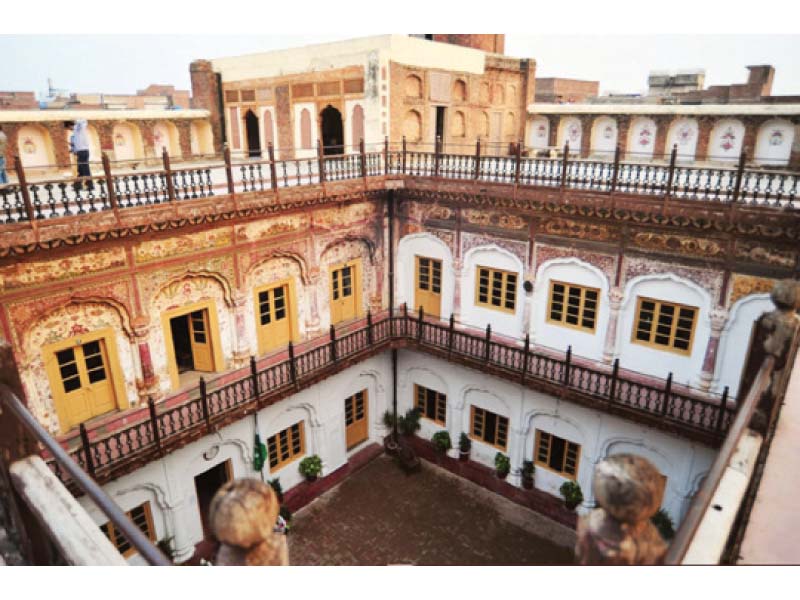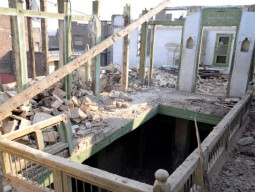
LAHORE:
When Ranjit Singh’s grandson Nau Nihal Singh constructed his three-storey haveli inside Mori Gate in the Walled City of Lahore, little did he know that it would eventually become a place of learning.
Since 1887, the 40-room complex has housed the government-run Victoria Girls High School. Some of the girls who studied here now live in India. Today it has over 1,300 students.
History, however, cannot be ignored in such a place. It is visible in the ornamentation of the facade, the wooden balcony around the courtyard and the frescos painted on the walls. The generations that continue to study at the school bear a sense of it.
Architect Rabia Nadir, a professor at Lahore School of Economics, says the building is one of the few remaining royal residences from the Sikh period. “The best feature of the haveli, and the best preserved, is the sheesh mahal on the third floor,” she says. The narrow room is made in the traditional style with a wooden ceiling. Geometrical patterns developed with wooden beading, small mirrors and painted designs reflect the influence of the Mughals who once ruled the Subcontinent.
She says it is intriguing that even though the building was built by Sikhs, it borrowed heavily from Hindu texts in its ornamentation. “[It] is among the best specimens of Sikh mural painting, both in terms of quality and state of preservation,” Nadir says of the story of Krishna painted on the walls.
In deference to the historical background of the complex, the school’s principal, Nasira Rafiq says she proposed to move the school out in order to preserve the heritage building. In the end, she yielded to pressure from students’ parents. “We decided to move out of this building a number of times, but the parents objected,” she says, adding that it is easily accessible to students most of whom come from the Walled City. In 1992, the school administration converted it into a higher secondary school and a portion was added to make room for more students.
Nadir, too, believes that despite the wear and tear caused by its use as a school building, it should remain an academy. “When you talk to the teachers and students they have a sense of pride about the building. They need to be connected to it,” she says.
Their lack of knowledge of its history can be gauged from the school magazine, which refers to Nau Nihal Singh as a son of Ranjit Singh.
In fact, he was the son of Kharak Singh and a grandson of Ranjit.
Nadir says the students should be taught about preservation and conservation of built heritage and about the Sikh rule.
Some of the teachers believe that the heritage appeal is fading away. “The history of the school has receded into the background of our daily routines,” says Shamim, who has been teaching here for seven years. “It is a safe haven for us. We come here to work everyday and forget the problems at our homes,” she adds. Sophia, an alumna of the school who now teaches here, shares the sentiment. “We are immensely proud of the school but once you come in everyday, it becomes more about the people we interact with and less about the history of the haveli,” she says.
The mansion may have lost some of its grandeur, but it continues to draw people to it. “A part of the film Bol was shot here,” informs another teacher, Samina. Art students also frequent the haveli and are enthralled by the design and ornamentation of the building.
Nadir says during his research on the Walled City, she had heard that patterned designs in the classrooms had been painted over with limewater. “I did not verify this but if it is true, the limewater should preserve them,” she says.
According to Rafiq, lack of funds limits endeavours. The Walled City of Lahore Authority (WCLA) – responsible for most of the city’s architecture – is also unable to protect the mansion. According to Zamirul Hassan of the Media and Marketing Wing of the WCLA, the building isn’t under the authority’s control. “It belongs to the Education department, which is also responsible for its maintenance,” says Hassan. “We are aware of its importance. That is why we have been considering including it in the route of our Rangeela Rickshaw ride,” he adds.
The lack of knowledge about the haveli’s history aside, the presence of students keeps the building alive. In fact, there is a magnetism that keeps drawing former students to their alma mater. Champa Sevin, who completed her matriculation from the school in 1942, visited from India to attend the celebration for its 125th anniversary in 2012. Nasira Rafiq recalls how it was an emotional moment for her. “She was hugging the walls of her old classroom and crying
Published in The Express Tribune, March 6th, 2016.





















































COMMENTS
Comments are moderated and generally will be posted if they are on-topic and not abusive.
For more information, please see our Comments FAQ